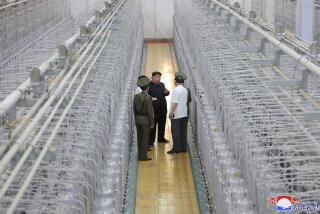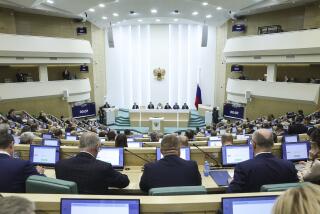Soviets Break With Secrecy, Let Foreigners View Main Nuclear Test Site
- Share via
GEGELEN HILLS, Soviet Union — In an unprecedented break with secrecy, the Soviet Union opened parts of its main nuclear test site in barren Central Asian granite hills for its first known inspection by foreigners.
A small group of journalists from the West and Japan as well as Soviet and Eastern Bloc reporters were shown shafts tunneled into hillsides where tests have taken place and one that 14 months ago had been prepared for an explosion.
Senior Soviet officers accompanying the party made it clear that the visit had been arranged to reinforce Moscow’s appeals to the United States to join in its year-old moratorium on nuclear testing.
“The aim of our journey is to show you that our test site is silent. We would like it to remain that way forever,” Gen. Yuri V. Lebedev of the Defense Ministry told the group Friday on the flight from Moscow.
At the site, in the Gegelen Hills about 90 miles west of the city of Semipalatinsk, rail tracks run to the rusted iron doors of two tunnels that the group was told have not yet been used for testing.
The only sign of activity, apart from a lone guard in a wooden watchtower near one of the tunnels, came from a herd of mountain goats scrambling over the crumbled granite hilltop.
The doors into one tunnel were unlocked, and the visitors were led about 100 yards along a rail track into the hillside.
Gen. Arkady D. Ilyenko, commander of the test zone area, said that all tests on the site were carried out in shafts bored horizontally into the granite and not dug down into the ground as many Western experts believed.
He said work on this tunnel was halted when the moratorium was declared seven months before it would have been ready for a test.
“If we never had to start up again, I’d be the happiest man on earth,” said Ilyenko. “But it’s up to the Americans to accept the hand we’re offering.”
Soviet leader Mikhail S. Gorbachev announced the moratorium on underground tests, the only ones still permitted under the 1963 Soviet-U.S. nuclear test ban treaty, on Aug. 6, 1985, and invited Washington to follow suit. The invitation has been extended to Jan. 1, 1987.
The Reagan Administration has declined to do so, saying that it needs to continue to maintain the efficiency of existing weapons.
Ilyenko said he could not accept a U.S. argument that there is still no fully reliable means of detection of nuclear blasts. “The Soviet-U.S. observer group shows that,” he said.
Since July, two American scientific observers and a team from the Soviet Academy of Sciences have been setting up three monitoring stations around the Semipalatinsk site under a private agreement.
Similar stations are to be established around the Nevada testing grounds, but so far the Soviet scientists due to take part have not received their U.S. visas, Foreign Ministry officials said.
The group of journalists also visited the two-man American team at a station they have established near the east Kazakhstan town of Karakalinsk.
David Chavez, 30, a seismologist from the University of Nevada at Reno, said their American equipment was able to register a U.S. test in Nevada on July 17, but not two subsequent smaller ones.
“There has been absolutely no sign of activity on the Soviet site since we’ve been here,” said Chavez. “There is no doubt whatsoever that we would know if there had been.”
More to Read
Sign up for Essential California
The most important California stories and recommendations in your inbox every morning.
You may occasionally receive promotional content from the Los Angeles Times.













